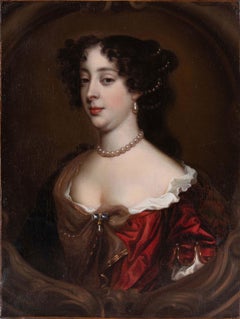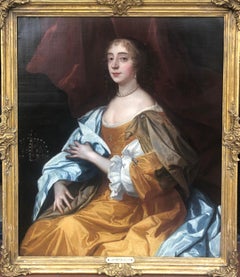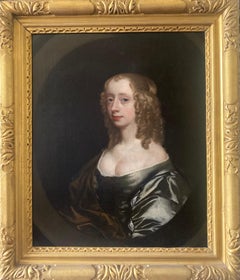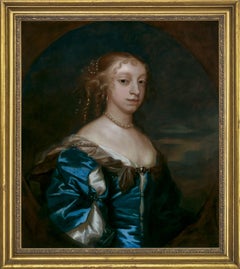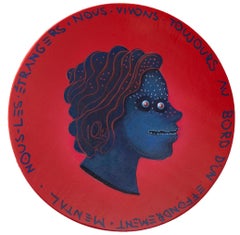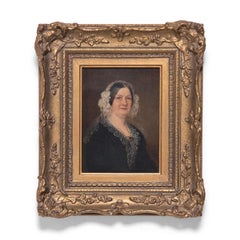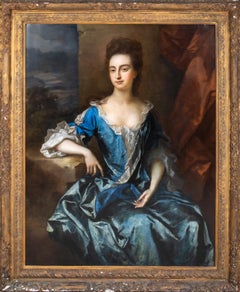Sir Peter Lely Portrait Paintings
Dutch, 1618-1680
Sir Peter Lely (1618-1680) was born in Germany at Soest in Westphalia in 1618. Though his family name was van der Faes, he assumed the name Lely after the lily that was carved on the gable of his father’s home in The Hague. He moved to England in 1641, the year that Van Dyck died, and succeeded Van Dyck. He was court painter to Kind Charles I and King Charles II. By working for many of the patrons of the late van Dyck, Lely rapidly established himself as one of the country’s most important portrait painters.to
2
1
2
1
Overall Width
to
Overall Height
to
4
1
4
3
3
3
1
1
4
4
2
2
5
280
83
78
76
3
4
Artist: Sir Peter Lely
Portrait of Barbara Palmer 1st Duchess of Cleveland
By Sir Peter Lely
Located in Taunton, GB
Portrait of Barbara Palmer 1st Duchess of Cleveland 1640-1709, half-length wearing a red dress and portrayed within a cartouche.
Circa 1680
Oil On...
Category
17th Century Sir Peter Lely Portrait Paintings
Materials
Oil
Portrait of Bridget Drury Lady Shaw, formerly Viscountess Kilmorey
By Sir Peter Lely
Located in London, GB
Sir Peter Lely (Soest 1618 – 1680 London)
Portrait of lady with a crown, possibly Bridget Drury Lady Shaw, formerly Viscountess Kilmorey, later Lady Baber (d.1696) c.1665
Oil on canvas
46 1/2 x 40 3/4 inches, Framed
42 1/4 x 36 1/4 inches, Unframed
Inscribed left [……….]Isabella
James Mulraine wrote the following for this piece:
This portrait dates to the middle of the 1660s, the decade when Lely’s career took off as successor to Sir Anthony van Dyck. At the Restoration Charles II had appointed him Principal Painter to the King and paid a pension £200 per annum ‘as formerly to Sr. Vandyke...’1 Lely had trained in Haarlem and he was in his early twenties when he came to London in 1643. He was an astute businessman and a wise courtier. In 1650 he painted a portrait of Oliver Cromwell (Birmingham Museum and Art Gallery) while maintaining links with the Royalist exiles through the 1650s. He had arrived in England as a painter of small-scale portraits and lush scenes of nymphs in landscapes in a Dutch style. His experience of Van Dyck in English collections transformed his painting. His lavish and alluring vision of Arcadia exactly captured the spirit of the Court and as Principal Painter he dominated English portraiture for the next twenty years. Lely ran a highly efficient studio along Netherlandish lines, employing a team of specialists like the drapery painter John Baptist Gaspars and young artists-in-training like Nicolas de Largilliere. He had numerous rivals during that period, and by 1670 he had introduced numbered standard poses to speed up production, while collaborating with printmakers for further revenue and advertising. He died in 1680 of a stroke while painting, working to the last.
The portrait, painted at a date when Lely’s poses and execution were still individual and inventive shows a lady sitting at three-quarter length facing away from the viewer. She has begun to turn towards the viewer, a pose with a long pedigree in art, first used by Leonardo da Vinci in the Mona Lisa (Louvre). She steadies her blue drapery where it might slip from her arm with the movement, a flash of realism beautifully captured. Like Van Dyck, Lely painted his female sitters in a timeless costume rather than contemporary fashion, showing a loose gown and floating silk draperies. It presented the sitter as a classical ideal. The portrait would not date.
The saffron dress may be the work of a drapery painter but the brown scarf must be by Lely himself, and appears unfinished, broadly sketched in behind the shoulder. The delicate blue glaze and nervous highlights suggest shimmering translucence. Lely was a master of painting hands – his hand studies are marvels of drawing – and the lady’s hands are superb, exactly drawn, delicately modelled and expressive. The fidgety gestures, clutching the gown, fiddling with the edge of the scarf, give the portrait psychological bite, suggesting the personality behind the calm courtier’s expression, adding to the sense shown in the look of the eyes and mouth that the lady is about to speak. The portrait’s language is Vandykian. The inspiration comes directly from Van Dyck’s English portraits of women. Lely owned Van Dyck’s Portrait of Lady Elizabeth Thimbleby and Dorothy Viscountess Andover (National Gallery, London) and the sitter’s costume quotes Lady Andover’s saffron dress and brown scarf. But Lely paints a generation who sat nearer to the ground and through a dialogue of expression and gesture he shows sitters who are more flesh and blood than Van Dyck’s.
The background with a column and curtain is different to those shown in most of Lely’s portraits of women. They tend to include trees or fountains, with a glimpse of landscape. But there are other examples. A portrait of the King’s reigning mistress, Barbara Villiers Duchess of Cleveland...
Category
1660s Sir Peter Lely Portrait Paintings
Materials
Oil
$69,264 Sale Price
20% Off
English 17th century portrait of a lady
By Sir Peter Lely
Located in Bath, Somerset
A 17th century English portrait of a lady by Sir Peter Lely (1618-1680), half-length in a painted feigned oval, wearing a green silk gown with chestnut coloured cloak over one shoulder, her fair hair curled in the fashionable ringlet style of the period. Oil on canvas in an English giltwood 'Lely' frame.
We are grateful to Diana Dethloff and Catharine MacLeod (who are currently working on a Lely catalogue raisonné) for their confirmation of Lely as the artist from photograph analysis of this previously unidentified early work.
Provenance:
Private collection Nottingham until 2021
Mellors and Kirk sale December 2000, lot 1173
The sitter is likely to have been from an upper class or aristocratic family in court circles, who were the main source of Lely`s patronage. The simple composition serves to highlight the beauty of the sitter through portraying her pale decolletage and complexion, set against the gentle gaze of her blue eyes, the soft blush of her cheeks and her full red lips.
Peter Lely (1618-1680) was originally of dutch origin and became Principle Painter to the King in 1661, following in the footsteps of Van Dyck who had died in 1641. He dominated the portrait painting scene in England for over 20 years, creating a distinctive 'court look' in his work which had a strong influence on many other artists. He had an extremely successful and popular portrait practice which meant that he soon had to develop production methods that could accommodate the high demand for portraits, and also for copies and versions of them which were given as gifts to family and courtiers. The use of studio assistants was a common practice for busy artists and as with Van Dyck, Lely is known to have used specialist assistants to execute particular parts of his paintings. Artists who worked in Lely`s studio included John Baptist Gaspars who specialised in drapery painting, William Wissing, John Greenhill...
Category
17th Century Baroque Sir Peter Lely Portrait Paintings
Materials
Canvas, Oil
$23,589 Sale Price
20% Off
Portrait of Lady Diana Bruce in Blue Dress & Cut Sleeves c.1660-1670, Peter Lely
By Sir Peter Lely
Located in London, GB
Portrait of Lady Diana Bruce in a Blue Dress with Cut Sleeves c.1660-1670
Circle of Sir Peter Lely (1616-1680)
Presented is a captivating portrait of the noble Lady Diana Bruce; it ...
Category
17th Century Old Masters Sir Peter Lely Portrait Paintings
Materials
Oil, Canvas
Related Items
"Currency #201" Blue Portrait Artwork with French Text on Red Background
By Natasha Lelenco
Located in FISTERRA, ES
“Currency #201” is a circular mixed media portrait on wood featuring a surreal blue figure against a vibrant red background. Around the head, the French inscription reads: “Nous, les...
Category
2010s Pop Art Sir Peter Lely Portrait Paintings
Materials
Wood, Spray Paint, Acrylic
$152 Sale Price
33% Off
H 0.99 in Dm 10.24 in
Oil Portrait of a Victorian Lady, c. 1850
Located in Chicago, IL
Painted in the 19th century, this exquisite miniature portrait wonderfully exemplifies realism in traditional oil painting. The small artwork is painted in the conventional portraiture style of the Old Masters, and achieves soft realism with fine brushwork and a subdued, neutral palette. The half length portrait depicts a fine Victorian woman dressed in all black with a delicate lace collar and bonnet. She wears a ruby broach...
Category
Mid-19th Century Old Masters Sir Peter Lely Portrait Paintings
Materials
Oil
18th Century Venetian School Portrait of a Bishop Oil on Panel Green Brown Black
Located in Sanremo, IT
Painting oil on panel measuring 40 x 30 cm without frame and 48 x 38 with frame representing a great bishop of the Venetian school from the first half of the 18th century.
Very curi...
Category
Early 18th Century Italian School Sir Peter Lely Portrait Paintings
Materials
Oil, Wood Panel
$1,134 Sale Price
20% Off
H 15.75 in W 11.82 in D 1.19 in
17th Century Saint Jerome Francesco Fracanzano Saint Skull Oil on Canvas Red
Located in Sanremo, IT
Painting, oil on canvas, measuring 92 x 77 without frame and 107 x 82 cm with frame , depicting a Saint Jerome in ancient philosopher and ascetic version, typical of the greatest tra...
Category
Mid-17th Century Italian School Sir Peter Lely Portrait Paintings
Materials
Canvas, Oil
$10,457
H 36.23 in W 30.32 in D 1.58 in
Head of a Classical Poet (Socrates?)
By Pier Francesco Mola
Located in New York, NY
Provenance:
Possibly Antonio Amici Moretti, Rome, 1690
Roy Clyde Gardner, Union, Mississippi, 1970s until 2004; by whom given to:
Mississippi Band of Choctaw Indians, 2004-2010
Lit...
Category
17th Century Baroque Sir Peter Lely Portrait Paintings
Materials
Canvas, Oil
Neoclassical, renaissance, Biblical, St Sebastian "Martyrdom" (After Guido Reni)
By Giancarlo Impiglia
Located in Bridgehampton, NY
Part of Giancarlo Impiglia's iconic "camouflage" series in which, deviating from his signature style, he expresses his classical education, flawless technique, and concerns about the...
Category
2010s Sir Peter Lely Portrait Paintings
Materials
Canvas, Oil
Eastern European Mannerist Portrait in traditional dress 19th/18thC
Located in Hillsborough, NC
Eastern European young woman in traditional dress with silver lacings and jewelry holding an open book. This portrait pose is in the Renaissance period Mannerist style, and the young...
Category
17th Century Mannerist Sir Peter Lely Portrait Paintings
Materials
Canvas, Oil
$1,595 Sale Price
44% Off
H 18 in W 14 in D 2 in
Male and female portrait, both in silk kimono, possibly textile dealers
By Christoffel Lubieniecki
Located in Amsterdam, NL
CHRISTOFFEL LUBIENIECKI (1659-1729)
Pair of portraits of a gentleman and a lady, both in silk kimono, before a country house (circa 1680)
Indistinctly signed “C.......” on a box under the man’s left hand
Oil on canvas, 79.5 x 67 cm each
Both sitters are portrayed wearing a silk “Japanese” coat. During the second half of the seventeenth the Japanese silk coat, an adapted Japanese kimono, became a real vogue in the Dutch elite. The exclusive Dutch trade contacts with Japan can explain the popularity of the kimono-style silk coats in the Netherlands. Everybody who could afford one, dressed in such a fashionable and comfortable coat and, like the present sitters, some proud owners had themselves portrayed in a “Japanese” coat often together with an oriental carpet to underline their standing and international connections. These portraits are the work of the Polish-born portraitist Christoffel Lubieniecki (also known as Lubienitski, Lubinitski or Lubiniecki)
Lubieniecki was first trained in Hamburg under Julian Stuhr and after 1675 in Amsterdam under Adriaen Backer and Gerard de Lairesse. He specialized in landscapes, generally of an Italianate character, and in portraits. The loving execution of these contented burghers, enjoying the garden vistas of their country house, places him alongside Amsterdam portraitists such as Constantijn Netscher and Michiel van Musscher...
Category
1680s Old Masters Sir Peter Lely Portrait Paintings
Materials
Canvas, Oil
$37,600
H 31.34 in W 26.38 in D 1.97 in
17th Century Onorio Marinari Italian Religious Painting
By Onorio Marinari
Located in Roma, IT
A very important painting by the great artist of the Florentine school, Onorio Marinari.
Dr. Silvia Benassai has confirmed Marinari’s authorship of the Saint Margaret of Antioch; ava...
Category
Mid-17th Century Baroque Sir Peter Lely Portrait Paintings
Materials
Canvas, Oil
$30,550
H 37.41 in W 29.53 in D 3.94 in
"Virgen de la Almudena" Cusco Style Image of the Virgin Mary and Baby Jesus
By Martha Ochoa
Located in Austin, TX
By Martha Ochoa
Oil on Canvas
Canvas Size: 24" x 16"
Framed Size: 27" x 19.25"
This lovely painting by Martha Ochoa is from the Cusco tradition. The Cusco School was an artistic tra...
Category
1990s Baroque Sir Peter Lely Portrait Paintings
Materials
Canvas, Oil
"The Virgen de Huápulo" Depiction of the Virgin Mary by Martha Ochoa
By Martha Ochoa
Located in Austin, TX
By Martha Ochoa
Oil on Canvas
Canvas Size: 23.75" x 15.75"
Framed Size: 27" x 19.25"
This lovely painting by Martha Ochoa is from the Cusco tradition. The Cusco School was an artist...
Category
1990s Baroque Sir Peter Lely Portrait Paintings
Materials
Oil, Canvas
$2,950
H 23.75 in W 15.75 in
Baroque Style Oil Portrait, The Laughing Cavalier, Follower of Frans Hals
Located in Cotignac, FR
19th Century oil on canvas portrait of a cavalier. The painting is signed or annotated top right. There is a supplier's trade stamp to the back of the canvas.
A wonderful jewel of a...
Category
19th Century Baroque Sir Peter Lely Portrait Paintings
Materials
Oil, Canvas
$2,585
H 10.63 in W 8.67 in D 0.6 in
Previously Available Items
Portrait Of Mrs Elizabeth Levinz (nee Livesay), 17th Century by SIR PETER LELY
By Sir Peter Lely
Located in Blackwater, GB
Portrait Of Mrs Elizabeth Levinz (nee Livesay), 17th Century
by SIR PETER LELY (1618-1680)
Large 17th Century portrait of Mrs Elizabeth Levinz (nee Livesay), oil on canvas by Sir P...
Category
17th Century Sir Peter Lely Portrait Paintings
Materials
Canvas, Oil
Sir Peter Lely portrait paintings for sale on 1stDibs.
Find a wide variety of authentic Sir Peter Lely portrait paintings available for sale on 1stDibs. You can also browse by medium to find art by Sir Peter Lely in oil paint, paint, canvas and more. Not every interior allows for large Sir Peter Lely portrait paintings, so small editions measuring 21 inches across are available. Customers who are interested in this artist might also find the work of and Suzi Fadel Nassif. Sir Peter Lely portrait paintings prices can differ depending upon medium, time period and other attributes. On 1stDibs, the price for these items starts at $11,379 and tops out at $83,120, while the average work can sell for $29,710.
Artists Similar to Sir Peter Lely
Questions About Sir Peter Lely Portrait Paintings
- 1stDibs ExpertJanuary 19, 2025Sir Peter Blake was famous for his influence on the art world. He is widely regarded as the godfather of British Pop art and the Young British Artists (YBA) movement. Blake created paintings, collages and prints that blended modernity and nostalgia. Though best known for designing the album cover for the Beatles’s Sgt. Pepper’s Lonely Hearts Club Band, he considered painting to be central to his oeuvre. While celebrity figures such as Marilyn Monroe informed Blake's work, folk art, fairground signs and an overall sense of nostalgia also influenced his style. On 1stDibs, explore an assortment of Peter Blake art.
